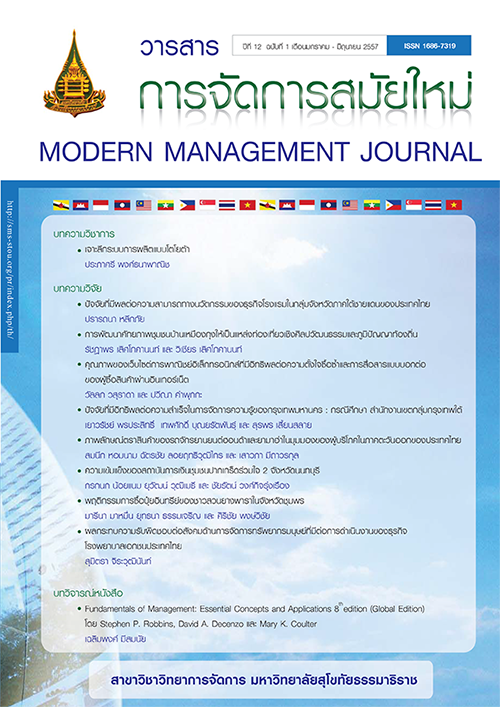การพัฒนาศักยภาพชุมชนบ้านเหมืองกุงให้เป็นแหล่งท่องเที่ยวเชิงศิลปวัฒนธรรมและภูมิปัญญาท้องถิ่น
Keywords:
การพัฒนาศักยภาพชุมชน, บ้านเหมืองกุง, ท่องเที่ยวเชิงศิลปวัฒนธรรมและภูมิปัญญาท้องถิ่น, Potential development of community, Ban Muang Kung, Artistic Cultural TourismAbstract
บทคัดย่อ
การวิจัยเรื่อง การพัฒนาศักยภาพชุมชนบ้านเหมืองกุงให้เป็นแหล่งท่องเที่ยวเชิงศิลปวัฒนธรรมและภูมิปัญญาท้องถิ่น ของอำเภอหางดง จังหวัดเชียงใหม่ มีวัตถุประสงค์เพื่อศึกษา (1) ศักยภาพของชุมชนบ้านเหมืองกุง ( 2) การมีส่วนร่วมในด้านการพัฒนาชุมชน (3) ศักยภาพในด้านสภาพแวดล้อมของชุมชน (4) ปัญหา อุปสรรค และแนวทางการพัฒนาชุมชน และ (5) แนวทางการจัดการด้านการท่องเที่ยว โดยมีเป้าหมายเพื่อให้ชุมชนบ้านเหมืองกุงเป็นแหล่งท่องเที่ยวเชิงศิลปวัฒนธรรมและภูมิปัญญาของท้องถิ่น
การวิจัยครั้งนี้เป็นการวิจัยเชิงสำรวจและเชิงคุณภาพ ประชากรที่ใช้ในการศึกษามี 4 กลุ่ม กลุ่มที่ 1: กลุ่มผู้บริหารและผู้นำชุมชน กลุ่มที่ 2: กลุ่มผู้ผลิตหรือผู้ประกอบการ กลุ่มที่ 3: กลุ่มนักท่องเที่ยว กลุ่มที่ 4 : กลุ่มตัวแทนของครัวเรือน เครื่องมือที่ใช้ในการเก็บรวมรวมข้อมูล กลุ่มที่หนึ่งใช้แบบประเมินมาตรฐานคุณภาพแหล่งท่องเที่ยว และการสัมภาษณ์ กลุ่มที่ 2 ใช้แบบสัมภาษณ์ สำหรับกลุ่มที่ 3 และ 4 ใช้แบบสอบถาม ข้อมูลที่เก็บรวบรวมมาได้ทำการวิเคราะห์โดยใช้โปรแกรมสำเร็จรูปด้วยค่าสถิติ ค่าร้อยละ ค่าเฉลี่ย ค่าเบี่ยงเบนมาตรฐาน และ ค่าความถี่
ผลการวิจัยพบว่า(1) ศักยภาพของชุมชนบ้านเหมืองกุง ในความเห็นของผู้บริหารและผู้นำชุมชนเห็นว่าด้านบริหารจัดการด้านการอนุรักษ์แหล่งท่องเที่ยวและสภาพแวดล้อมยังไม่มีความพร้อม ส่วนด้านผู้ประกอบการมีความเห็นว่า ช่างฝีมือที่มีอยู่ในปัจจุบันในท้องถิ่นมีความพร้อมในการถ่ายทอดความรู้ที่เป็นภูมิปัญญาท้องถิ่นให้กับคนรุ่นใหม่ แต่คนรุ่นใหม่ในชุมชนยังไม่มีความพร้อมในการรับการถ่ายทอด ในขณะที่กลุ่มนักท่องเที่ยวมีความเห็นเกี่ยวกับความพร้อมและความ สามารถของชุมชนบ้านเหมืองกุงว่า มีในระดับมากทั้งในด้านฝีมือการปั้น ลักษณะการปั้น การออกแบบที่มีเอกลักษณ์เฉพาะของชุมชน และ รูปแบบผลิตภัณฑ์ (2) การมีส่วนร่วมในด้านการพัฒนาชุมชนให้เป็นแหล่งท่องเที่ยวพบว่า ประชาชนยอมรับในด้านประโยชน์โดยรวมจากการท่องเที่ยวในระดับมากแต่การให้ความร่วมมือยังอยู่ในระดับปานกลาง เพราะมีความคิดเห็นที่แตกแยกกัน ความคิดด้านการพัฒนามีความเหลื่อมล้ำระหว่างผู้นำชุมชนกับประชาชน ส่วนผู้บริหาร ผู้นำชุมชนมีความเห็นว่า ควรมีการรณรงค์ให้คนในชุมชนมีความร่วมมือกันและเข้ามามีส่วนร่วมในการพัฒนาชุมชนให้มากขึ้น (3) ศักยภาพในด้านสภาพแวดล้อมในการพัฒนาพบว่า มีความเห็นแยกออกเป็น 2 แนวทาง โดยผู้บริหาร ผู้นำชุมชน เห็นว่ามีความเหมาะสมและมีความสะดวกในระดับมาก ในขณะที่นักท่องเที่ยวมีความเห็นแตกต่างโดยเห็นว่ายังต้องพัฒนาในอีกหลายๆ ด้าน (4) ปัญหา อุปสรรค และแนวทางการพัฒนาชุมชน ด้านผู้บริหาร ผู้นำชุมชนมีความเห็นว่า เนื่องจากความร่วมมือของคนในชุมชนยังมีน้อย ไม่มีการจัดการด้านการท่องเที่ยวอย่างจริงจัง และขาดคนรุ่นใหม่ที่จะมาสืบทอดภูมิปัญญาท้องถิ่น จึงต้องมีการจัดทำแผนงานที่ชัดเจนโดยให้หน่วยงานที่มีความรู้ทางวิชาการเข้ามาร่วมพัฒนาหรือให้ความรู้ที่ถูกต้องและภาครัฐจัดสรรเงินงบประมาณสนับสนุน ส่วนทางด้านผู้ผลิต ผู้ประกอบการ มีความเห็นว่า มีปัญหาด้านการออกแบบผลิตภัณฑ์ที่ไม่ตรงกับความต้องการ มีปัญหาด้านการผลิตและคุณภาพของวัตถุดิบ รวมทั้งขาดการประชาสัมพันธ์และการจัดกิจกรรม ส่วนในด้านความคิดเห็นของนักท่องเที่ยวเห็นว่าชุมชนบ้านเหมืองกุงยังต้องมีการพัฒนาในระดับมาก ทั้งในด้านการประชาสัมพันธ์ ทรัพยากรธรรมชาติ กิจกรรม เศรษฐกิจ และโครงสร้างพื้นฐาน (5) แนวทางการจัดการด้านการท่องเที่ยว ผู้มีส่วนได้เสีย เห็นว่าควรจัดทำแผนงานการท่องเที่ยวที่ชัดเจน สร้างการมีส่วนร่วมของคนในชุมชนโดยดึงเยาวชนในชุมชนให้เข้ามามีส่วนร่วม รวมทั้งควรพัฒนาปรับปรุงโครงสร้างพื้นฐาน และ สภาพแวดล้อมด้านทรัพยากรธรรมชาติ
Abstract
The objectives of this research are to study 1) the potential of Muang Kung community; 2) the participation in developed community into tourist attraction; 3) potential environmental and community development; 4 ) problems, obstacles and guidelines of community development; and 5) approach to tourism management that aims at Muang Kung community to be artistic cultural tourism of Chiang Mai province.
The method of this research is survey and qualitative research. Using 4 groups of population: 1) executives and community leaders; 2) manufacturer and entrepreneur; 3) tourist; and 4) representative local people in the community. The instruments used to collect data consist of assessment form quality tourism standard of the Tourism Authority of Thailand; interview and questionnaires. The data were analyzed by using standard deviation, mean, percentage and frequency.
The research reveals the following; 1) Potential of Muang Kung community and the opinion of executives and community leaders show that the management tourism and environmental conservation do not do not have high potential. In the opinion of entrepreneur the existing local craftsman are ready to convey the knowledge to the young new generation, but the young people are not ready to receive the knowledge transfer of the pottery craft. While tourists have commented on the availability and capability of Muang Kung community in high level of pottery handcraft; style, design with specific identity of community and product designs. 2) For participation in developed community into tourist attraction, it was found that the public accept the overall benefit of tourism on high scale; however, cooperation is at the medium level because of different opinion. The opinion in development is difference between leaders of the community and public in the community; executives and community leaders agreed that there should be a campaign to people in the community collaboration and participation in community development. 3) For potential environmental and community development, it was found that they are two approaches. Executives and community leaders agreed that there are appropriate and convenient on high scale while tourists have different opinion that it has to be developed in many areas. 4) Problem obstacles, according to the executives and community leaders was due to the insufficient cooperation of the community and no serious management of tourism. Also there is lack of new generation willing to inherit knowledge of the pottery craft. The explicit plan using the organization which has academic knowledge must be implemented. In the opinion of manufacturer and entrepreneur, they claimed that they have the problems of product design, production, quality of raw material, lack of publicity and events. Also, in the opinion of the tourists, they agreed that Muang Kung community has to develop in many areas; public relations, natural resources, activity, economics and infrastructure. 5) The travel plan should be made clear with improved infrastructure, natural environment in the community. Collaboration of people in the community especially young generation to develop the community to be artistic cultural tourism must be encouraged.



